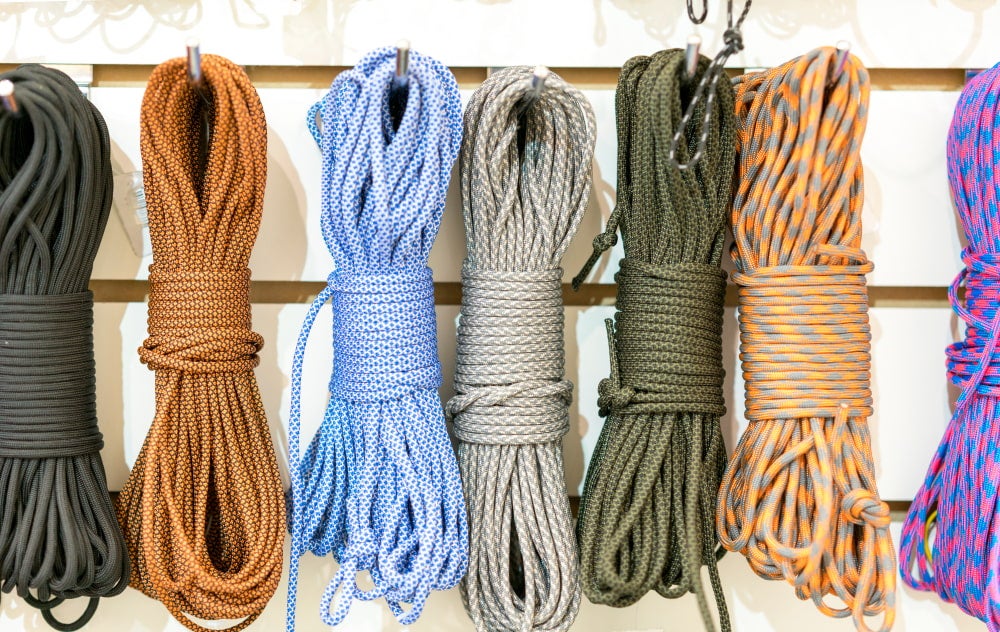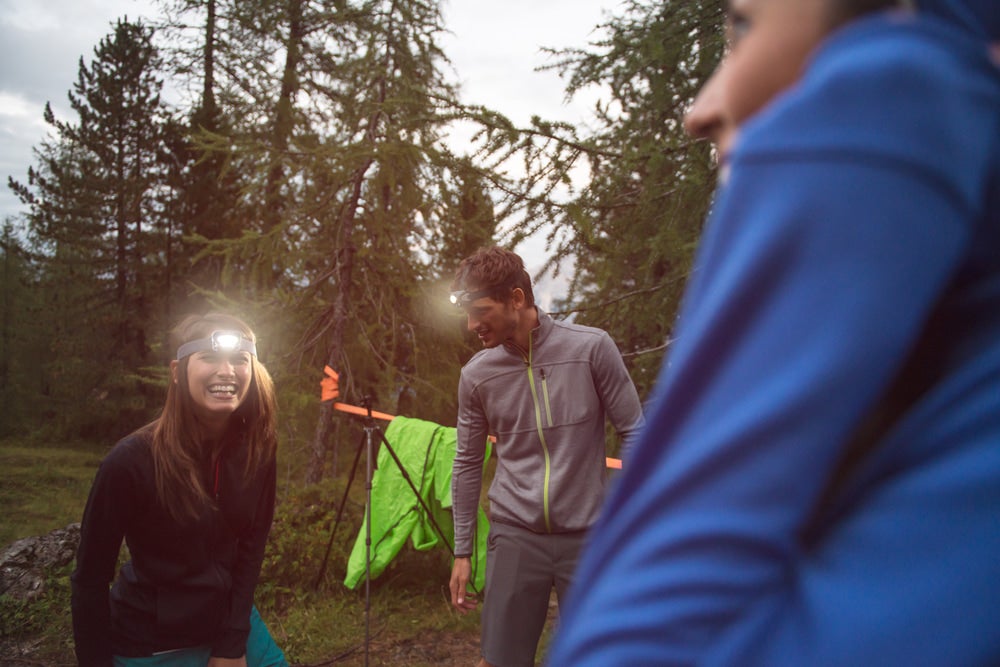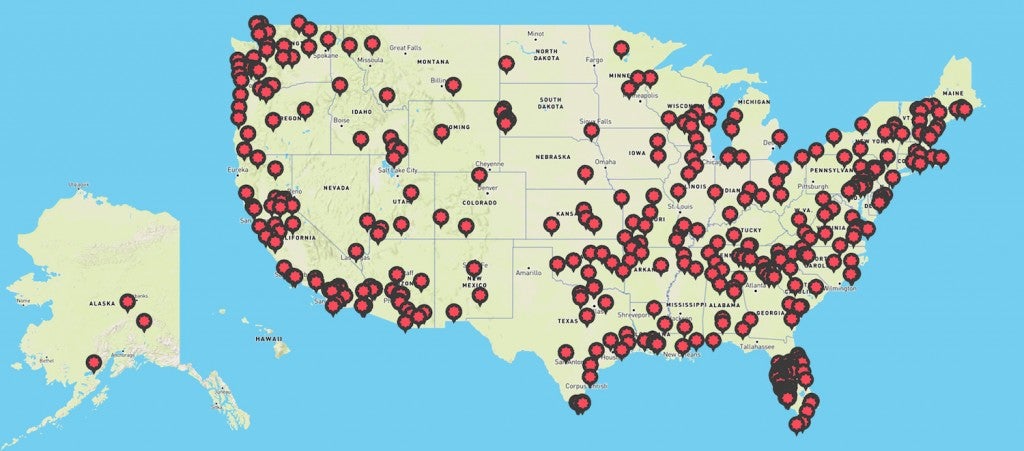This article is brought to you by The Dyrt PRO. Try out The Dyrt PRO and find free camping to test out your new wilderness survival tools.
Whether you’re planning your first backcountry trip, want to test your survival skills in the wilderness of Alaska, or are getting a crash course at a destination like the Bear Grylls Adventure Park, it’s important to have packed the right survival gear.
14 Wilderness Survival Tools You Should Always Have In Your Pack
We’ve rounded up fourteen of the best wilderness survival tools you can easily stash in your day pack or include in your camping kit. Whether your adventure outdoors goes sideways or not, all of these items will either come in handy for setting up camp or building confidence.
1. Fire Starter

According to Maslow’s Hierarchy of Needs, there’s nothing more important than food, water, warmth, and rest. A fire starter is perhaps the single most important survival tool you can have in your kit, because it will help you cook food, boil water, stay warm, and sleep safely without worrying about predators.
There are many different types of fire starters you can choose from, but one of our favorites for sheer utility is the Firebiner, a carabiner equipped with a small blade and a farro sparking fire starter.
2. Survival Knife/ Multi-Tool
Choosing the right multi-tool, survival knife, or a combination of the two is a pretty personal decision. Find a tool that has features well-aligned with your skills and the type of tasks you anticipate performing, and is the right size and weight for your kit.
Some people feel safer knowing they have a knife in tow, while others prefer to stick to just a multi-tool that won’t attract attention. There’s compact, machete-like blades that will help you chop firewood, like the Karen Hood Chopper.
For multitools checkout the Leatherman Style CS, which is packed with essentials like scissors, a file, knife, tweezers, bottle opener and mini-screwdriver. You can even get tactical pens in case scribbling notes is part of your emergency plan. Whatever you choose, always keep it in your pack.
Prepare for your next adventure by downloading maps. The Dyrt PRO lets you download maps and campgrounds without cell service. “My alternative to using pro would be to drive back out to cell service”.
3. Topographic Map

Even if you’re going on a flat, short day hike in a familiar area, you should always have a topographic map on hand. It’s easy to get turned around and lost if you step off trail, even in your most frequented stomping grounds.
While it’s still very unlikely for you to get lost on a hike or backpacking trip, it’s smart to learn how to read a topographic map. It’ll be a fun way to learn more about the area, and could be one of the survival tools that helps save your life.
4. Compass
Much like your topographic map, a compass is an absolute necessity. It’s lightweight, analog, and easy to use alone or with other tools— if you know how to read one correctly. Take an orienteering class with your local outfitter or hiking/mountaineering organization so that you will know precisely how to use this classic survival tool in a pinch.
5. First Aid Kit

A medical kit can be invaluable in the backcountry, especially if you’ve found yourself in a survival scenario because of illness or an accident. Think beyond Band-Aids and antibiotic ointment for cuts and scrapes, and include other items that can double as survival tools. ACE bandages can serve a variety of purposes, gauze pads for larger wounds, splints for supporting fractures, steri-strips to help close wounds with uneven edges, and alcohol prep pads that can be used for a variety of purposes.
You can save a lot of the guesswork by purchasing a first aid kit designed specifically for outdoor survival. Keep one in your pack at all times (the last thing you want is for it to be in your car at the trailhead or your campsite a few miles away when disaster strikes). It can also be a good idea to purchase a separate first aid kit and keep it in your vehicle, especially if you’re frequently car camping or rocking the vanlife.
Prepare for your next adventure by downloading maps. The Dyrt PRO lets you download maps and campgrounds without cell service. “My alternative to using pro would be to drive back out to cell service”.
6. Emergency Survival Whistle
A good, loud whistle comes in handy for all sorts of wilderness applications. It’s one of the most essential survival tools when you are frequently going into the backcountry where people are few and far between and wildlife is abundant.
A whistle of at least 100 decibels will cut through ambient noise and travel great distances, plus alert animals like bears to your presence. Keep it attached not just to your pack, if possible, but to your person, in case you get separated from your gear.
7. Paracord

Everyone from serious hikers to the hobbits in Lord of the Rings will expound on the importance of traveling with rope. But for the modern survivalist paracord, which was invented in 1935 for military use, is the way to go.
Because it’s made of lightweight, sturdy nylon and multiple strands of fiber, paracord is incredibly useful as a survival tool. It can be used to rig tarps and repair gear (or even the Hubble Space Telescope), taken apart for sewing thread or fishing line, or braided together to create a broader, stronger rope. A wearable survival rope bracelet, like Outdoor Element’s that uses high-strength paracord, gives you access to rope on your person at all times.
8. Water Filtration
The average human can only survive about three days without water. Not only should you always carry more than you think you’ll need for your hike in case of delays, but it’s also smart to have some type of water filter on hand, too.
In a survival scenario, you may need to collect and treat water to stay hydrated while you wait for help or hike out. You might also need to treat water so you’ll have it on hand for cleaning wounds, repairing gear, or cooking food.
9. Flashlight / Head Lamp

The only thing harder than being lost, stuck in a backcountry emergency, or trying to survive the unexpected is having to manage in the dark. Even if you’re only planning a day hike, it’s always wise to have your headlamp on hand, or at least a small pocket-size flashlight.
10. Tarp
You can’t always count on being able to build a survival igloo, and sometimes you want to save your space blanket for wrapping around your body, not hanging over your head. That’s why a tarp is such a key survival tool.
You can use the tarp as a ground pad for your tent, as a cover for your campsite, to protect gear from the elements, as a prep surface for food, or even to collect drinking water. There are few items in any survival kit as versatile as a good, sturdy tarp.
11. Signal Mirror

Sometimes called a rescue mirror, these unbreakable reflectors are designed specifically for outdoor applications and as survival tools. On any regular day, you can use the mirror to help you apply sunscreen without missing a spot. If your trek goes sideways, however, you can use the mirror to signal for help. The reflected glimmer can reach up to seven miles depending on weather conditions, alerting pilots to your location and distress.
12. Space Blanket
Staying warm can be a big challenge in survival scenarios, even in conditions you might not expect. Temperatures can drop quickly after the sun goes down, especially in alpine or desert environments.
Moisture or humidity can have a big impact on the body’s ability to retain heat, too, even if the daytime temperature was warm. If your clothes or body are wet, you’re going to have to work that much harder to stay at a safe temperature. These lightweight blankets aren’t an alternative to a sleeping bag but are perfect in a bind. They reflect your body heat back at you very effectively, making it easier to stay warm and dry.
That’s not the only way you can use a space blanket as a survival tool, however. You can use the power of the sun or a candle to cook food using the space blanket as a reflector. You can use it to signal for help or show which way you went. You can even use it to supplement a tarp or ground pad as part of your shelter construction.
13. SPOT locator

While a topo map and compass are important, it’s even better to have modern technology. Instantly summon emergency responders to your exact location with a Spot.
A personal locator beacon doesn’t need a cell phone signal to send up your SOS signal, and will transmit your GPS coordinates no matter how far-flung. Some are also capable of messaging beyond a generic SOS so you can let friends or family know more details, like if you’re running late, but aren’t in immediate peril.
14. A dry bag or Ursack
Last but certainly not least, a dry bag or smell-proof Ursack is a great way to keep important survival tools like your matches, firestarter, phone, map, etc. safe and dry. If you go the Ursack route, you can also keep your food (or cannabis stash) from attracting unwanted attention while you try to get back to safety.
This article was brought to you by The Dyrt PRO

The Dyrt PRO gives 40% campground discounts across the country
Related Articles:
- Best Camping Blanket
- Campgrounds in Nebraska
- Backpacking Checklist
- Survival Books
Related Campgrounds:
- White Pines Campgrounds, Sleeping Bear Dunes, MI
The post 14 Wilderness Survival Tools You Should Always Have in the Backcountry appeared first on The Dyrt Magazine.


